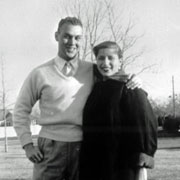-
(单词翻译:双击或拖选)
Supreme1 Court Justice Continues Equality Fight
Only the second woman in U.S. history to serve on the nation’s highest court, Ruth Bader Ginsburg knew she wanted to be a lawyer by her third year in college.
Early inspiration
It was during the “red scare” in the 1950s, when Americans were fearful of the Soviet2 Union. Led by Sen. Joseph McCarthy, thousands of people - especially in the entertainment industry and unions - were publicly accused of being Communists. Lives and careers were ruined.
“There were brave lawyers who were standing3 up for those people, and reminding our Senate, 'Look at the Constitution, look at the very First Amendment4, what does it say? It says we prize, above all else, the right to think, to speak, to write, as we will, without Big Brother over our shoulders.' And my notion was, if lawyers can be helping5 us get back in touch with our most basic values, that’s what I want to be.”
Ginsburg’s parents discouraged her from studying law, fearful that she would not be able to find a job in the male-dominated profession. But she was determined6 and, after graduating from Cornell University in 1954, was accepted into Harvard Law School, just five years after they started admitting women.
“When I entered law school," Ginsburg says, "the class numbered over 500. Nine of us were women.”
| Detail of Harvard Law Review Board of Editors, 1957-1958. Ruth Bader Ginsburg (far right) was one of only two women on the prestigious7 panel. |
Two years later, Ginsburg's husband - Martin Ginsburg, a renowned8 tax attorney and law professor - took a job in New York City, and Ginsburg transferred to Columbia Law School, where she received her degree in 1959.
Breaking into a man's world
And, as her parents had predicted, she found breaking into a man’s world challenging.
“There wasn’t a single firm in the entire city of New York that was willing to take a chance on me,” she remembers.
But with the help of a sympathetic professor, she got a clerkship. Soon after, she started teaching at Rutgers University School of Law and Columbia Law School.
In 1972, Ginsburg co-founded the Women's Rights Project, an initiative of the American Civil Liberties Union, to work for equality for women and girls in all spheres of life.
“At that time there were many, many laws on the books that gave preference to men simply based on being men,” says Lenora Lapidus, who now runs the program. "Throughout the 1970s, as she led the Women’s Rights Project, Justice Ginsburg brought case after case to the Supreme Court in order to establish that the constitution prohibited sex discrimination.”
She was the lead attorney on Reed v Reed, a U.S. Supreme Court case which triggered the landmark9 1971 decision declaring it unconstitutional to discriminate10 against a woman solely11 because of her gender12.
Articulate voice
 |
| US Supreme Court justices pose for a group portrait in 1994. From left, front are: Antonin Scalia, John Paul Stevens, Chief Justice William Rehnquist, Sandra Day O'Connor and Anthony Kennedy. From left, back row are: Ruth Bader Ginsburg, David Souter, Clarence Thomas and Stephen Breyer. |
Two decades later, Ginsburg was a member of that court, appointed in 1993, by President Bill Clinton. Since then, she has been an articulate voice for the liberal wing of the bench.
According to Ginsburg, gender barriers facing women in the workplace today have all but disappeared in the United States. What remains13, she says, is something a court cannot mandate14: for American society to be open to the idea that women, and men, need a balance between work and family.
Ginsburg balanced her own life as a working mother of two children, with the love and support of her husband Martin, who died last year.
"The most important thing, by far, was that I had a life partner, my husband, who thought my work was at least as important as his," she says, "and who wanted very much to be part of his children’s growing-up years.”
 |
| Martin D. Ginsburg and Ruth Bader Ginsburg taken in the fall of 1954 when Martin Ginsburg was serving in the Army. |
At 78, Supreme Court Justice Ginsburg says she has always tried to do what she believes is right.
“I hope that I will be remembered as someone who loves the law, loves her country, loves humanity, prizes the dignity of every individual, and works as hard as she can with whatever talent she has, to make the world a little better than it was when I entered it.”
 收听单词发音
收听单词发音
1
supreme

|
|
| adj.极度的,最重要的;至高的,最高的 | |
参考例句: |
|
|
|
2
Soviet

|
|
| adj.苏联的,苏维埃的;n.苏维埃 | |
参考例句: |
|
|
|
3
standing

|
|
| n.持续,地位;adj.永久的,不动的,直立的,不流动的 | |
参考例句: |
|
|
|
4
amendment

|
|
| n.改正,修正,改善,修正案 | |
参考例句: |
|
|
|
5
helping

|
|
| n.食物的一份&adj.帮助人的,辅助的 | |
参考例句: |
|
|
|
6
determined

|
|
| adj.坚定的;有决心的 | |
参考例句: |
|
|
|
7
prestigious

|
|
| adj.有威望的,有声望的,受尊敬的 | |
参考例句: |
|
|
|
8
renowned

|
|
| adj.著名的,有名望的,声誉鹊起的 | |
参考例句: |
|
|
|
9
landmark

|
|
| n.陆标,划时代的事,地界标 | |
参考例句: |
|
|
|
10
discriminate

|
|
| v.区别,辨别,区分;有区别地对待 | |
参考例句: |
|
|
|
11
solely

|
|
| adv.仅仅,唯一地 | |
参考例句: |
|
|
|
12
gender

|
|
| n.(生理上的)性,(名词、代词等的)性 | |
参考例句: |
|
|
|
13
remains

|
|
| n.剩余物,残留物;遗体,遗迹 | |
参考例句: |
|
|
|
14
mandate

|
|
| n.托管地;命令,指示 | |
参考例句: |
|
|
|















